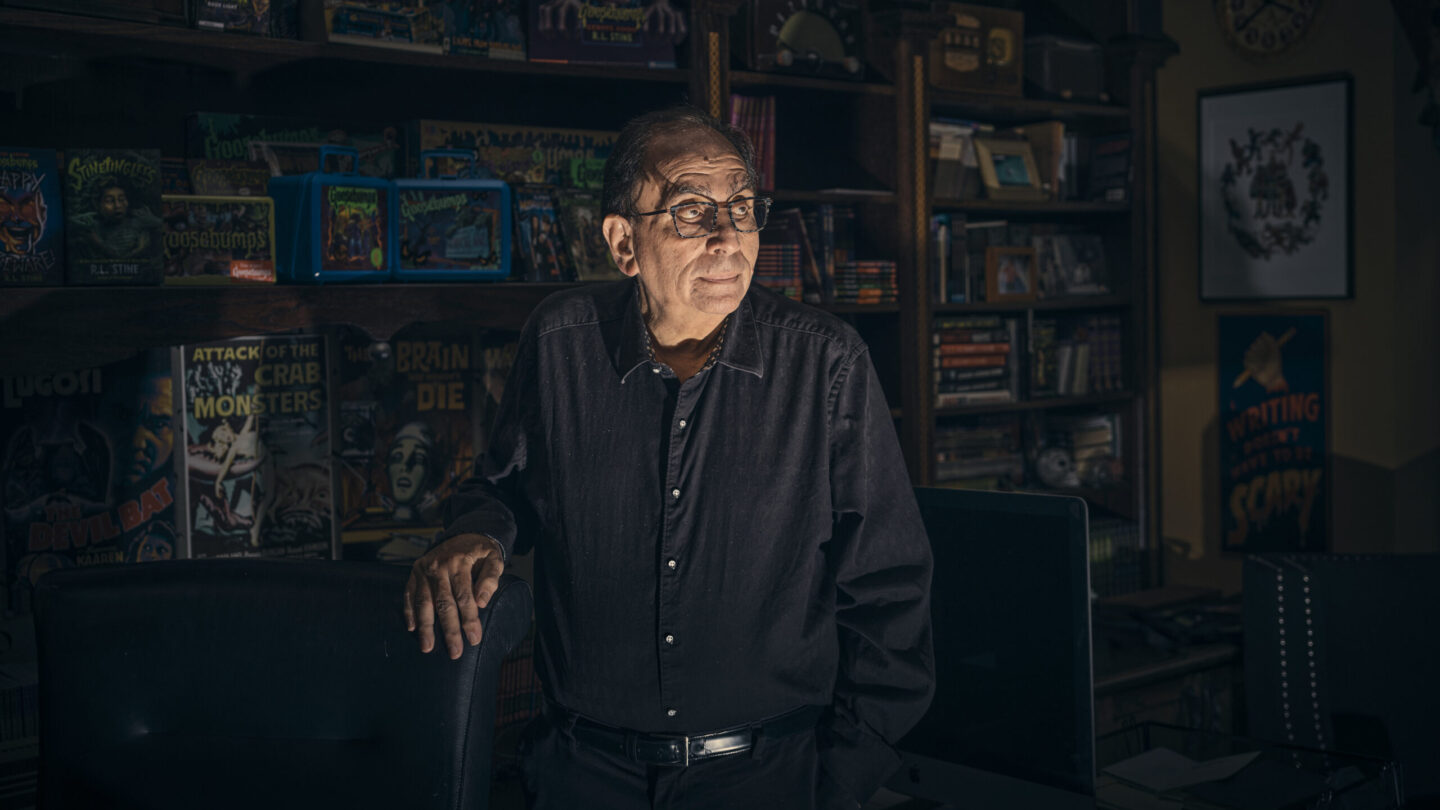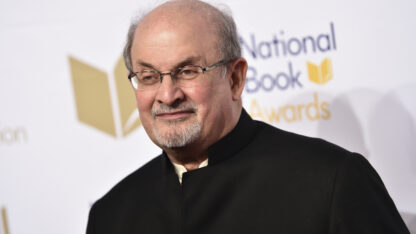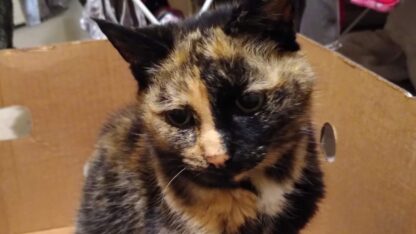There are plenty of cockroaches in New York City, but at R.L. Stine’s house, you’ll find a 3 foot one.
OK, not an actual roach. It was just one of the many horror-based knick knacks lying around his office, which was filled with Goosebumps lunchboxes and dolls and, of course, books.
Was that slight mis-direct about the roach kind of cheap? An easy way to (hopefully) hook a reader? Absolutely. But it’s the kind of thing that Stine has built his career on — cheap tricks and teases. ” ‘Goosebumps’ is mostly teases,” he says.
“I don’t really want to terrify kids. It’s not what I really want. If I think a scene is getting too scary, too intense, I throw in something funny.”
Stine’s mega-popular kids book series “Goosebumps” turns 30 this year. It’s a franchise that’s spawned TV shows, movies and even more books. And even if its popularity has waned in recent years (“I don’t have the same sales as the 90s. We love the 90s,” he says), the series continues to have its hooks, tentacles, or some other creepy tendrils around fans today.
Coming to terms with becoming nostalgia
Stine is celebrating the anniversary with a couple of new books and a handful of appearances. When we met, he was fresh from an appearance at New York City Comic Con, meeting and greeting a hoard of fans, and he was getting ready to appear at the Library of Congress to take questions from children. In a way, Stine is in a sweet spot with his audience — his original fan base is now old enough to be sharing “Goosebumps” with their own kids. “You get old. That’s a tough pill to swallow,” he says. “Terrible. But what a thrill. I get to scare a lot of generations, don’t I?”
Stine is originally from Ohio. He moved to New York with big dreams of becoming a writer – just not the type of writer he became. He started out as a humorist, editing a magazine with his friend Jean Feiwel who was also an editor at Scholastic. One day in the ’80s the two were having lunch, and she was supposed to be working on a horror book for teens called “Blind Date”, but the author had just dropped out. Desperate, she told Stine that he could write a horror novel for teenagers.
“I didn’t know what she was talking about,” he says. ‘What’s a horror novel for teenagers?”
“I was on a timeline,” recalls Feiwel. “I said ‘you know, like any blind date, it could turn horrific, so I’m sure you could find the horror in it. And the humor in it.’ “
Stine ran to a nearby bookstore and picked up anyone who was writing teen horror – Christopher Pike, Lois Duncan. He was a quick study. Feiwel guesses that he got the book written in about a week: “And I said, ‘oh my God, you’ve got a whole new career here.’ “
What the first ‘Goosebumps’ book got wrong
While “Blind Date” worked for teenagers, Stine shifted to writing a series for younger kids, at an age range book industry people call “middle grade.” The first “Goosebumps” book “Welcome to Dead House” was published in 1992. It’s about a family who moves into a creaky old house in a small town. Early on, Amanda has to go out looking for her brother, who’s gone missing. She finds him in a graveyard, of course.
I stepped down from the car, took a few steps onto the grass and called to him. At first he didn’t react to my shouts. He seemed to be ducking and dodging through the tombstones. He would run in one direction, then cut to the side, then head in another direction.
Why was he doing that?
I took another few steps – and then stopped, gripped with fear.
I suddenly realized why Josh was darting and ducking like that, running so wildly through the tombstones. He was being chased.
Someone or – something – was after him.
Stine now says he thinks this book is actually too scary – he hadn’t quite nailed down the balance between funny and frightful — but it had an effect on lots of young readers, like India Hill Brown. “I remember reading it as a kid, it was so scary,” says Brown. “And I remember reading it as an adult, it was so scary,” she laughs.
Brown is the author of two horror books for kids — “The Forgotten Girl” and “The Girl in the Lake”. She’d actually returned to “Welcome to Dead House” when working on her first book, during a rough patch of writer’s block. It helped her focus on “what made me love middle grade horror.”
It’s an interesting age, before you’ve realized that growing up is kind of awful. You’re on the precipice of not wanting to be a kid anymore — which is why “Goosebumps” protagonists tend to be 12 years old — just a little older than the target age range. You want to have a little independence, a touch of agency, but also feel safe. “My one rule for writing for 7 to 11 year olds is they can’t think it’s going to be real. They have to know it’s a fantasy. And then I can go pretty far with the scares,” says Stine.
It took a while for the “Goosebumps” hype train to take off, but when it did — it hit big. It inspired a kids TV show, merch and – to a certain type of superfan – the books themselves became collectables.
“I remember scouring bookstores each month when the next “Goosebumps” was supposed to come out,” superfan Brian Stelter tells me.
Stelter is best known for being the former chief media correspondent for CNN and host of the show “Reliable Sources”, but in the world of “Goosebumps” he’s famous for having created the fansite The Bumps. It wasn’t just any “Goosebumps” fansite: Stelter, slightly biased, called it the “number one unofficial ‘Goosebumps’ website.” To Stelter, the fact that he had competition online shows the power and reach of Stine’s books. “There were all these websites, including my own, that were obsessed with his creations and wanting to talk and share even more about them.”
Feiwel, the former Scholastic editor, said with “Goosebumps,” Stine pulled off a spectacular feat. Nobody back then was writing horror for middle grade kids. And Stine got them – boys in particular – reading.
When parents tried to ban ‘Goosebumps’
In 1997, a small group of parents in a Minneapolis suburb tried to get “Goosebumps” pulled from elementary school libraries. They claimed that the series wasn’t fostering healthy values in children, and that it was too scary. Stine chalked that up to parents who were just frightened by the covers, and didn’t actually read the books. The push to restrict the books eventually failed.
“We had so much support from teachers, librarians and reading teachers who saw that kids really went for them,” says Stine. “It really helped us a lot back then. They were always right behind ‘Goosebumps.’ “
Now would be the part of the profile where I tie something Stine said to a bigger story going on in the news — like the recent rash of book bannings. Or maybe land on a tidy summation of Stine’s work that points to a deeper meaning — like how “Goosebumps,“ like all good horror, actually plays off deeper, eternal fears: Do my friends like me? Are my parents acting weird?
But “Goosebumps,” for the past 30 years, has consistently, stubbornly, avoided deeper meanings or bigger lessons. In a way, those parents had a point. Stine wasn’t interested in teaching kids healthy values. He’s never been interested in teaching kids anything. Other than: Keep reading to find out what happens next.
Copyright 2022 NPR. To see more, visit https://www.npr.org.
9(MDAxODM0MDY4MDEyMTY4NDA3MzI3YjkzMw004))

9(MDAxODM0MDY4MDEyMTY4NDA3MzI3YjkzMw004))









